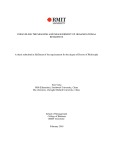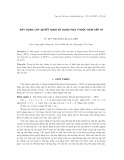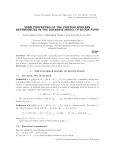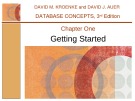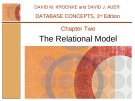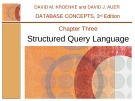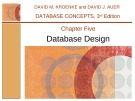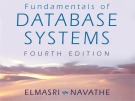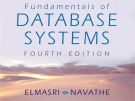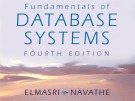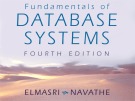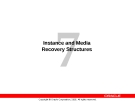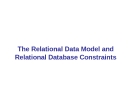
Database concepts
-
This thesis adopts a systematic and novel approach to evaluating what scholars have written via a comprehensive and technical examination of the literature (articles published between 1988 and 2016 across ten computerized databases). Major articles were systematically reviewed using a machine-based text analysis, Leximancer, revealing which themes pervade the field of scholarship based on what is written.
 175p
175p  runthenight04
runthenight04
 02-02-2023
02-02-2023
 8
8
 3
3
 Download
Download
-
The main contents of the chapter consist of the following: Function M-files, syntax of function M-Files, comments, multiple input and output functions, relational model concepts, relational model constraints and relational database schemas, update operations and dealing with constraint violations.
 34p
34p  nanhankhuoctai10
nanhankhuoctai10
 23-07-2020
23-07-2020
 21
21
 1
1
 Download
Download
-
In this paper, we introduce in brief on the concepts of Approximate Functional Dependency (AFD), of Approximate Functionally Cross-Characteristic Dependency known as type II AFD and describe an adoption of AFD to a constructing method of decisson tree for databases mining purposes.
 5p
5p  binhminhmuatrenngondoithonggio
binhminhmuatrenngondoithonggio
 09-06-2017
09-06-2017
 35
35
 2
2
 Download
Download
-
The report proposes the concept of positive boolean dependency in the database model of block form, proving equivalent theorem of three derived types, necessary and sufficient criteria of the derived type, the member problem... In addition, some properties related to this concept in the case of block r degenerated into relation are also expressed and demonstrated here.
 12p
12p  dieutringuyen
dieutringuyen
 07-06-2017
07-06-2017
 39
39
 2
2
 Download
Download
-
Chapter 1 - Getting started. After completing this unit, you should be able to: Identify the purpose and scope of this book, know the potential problems with lists, understand the reasons for using a database, understand how related tables avoid the problems of lists, learn the components of database system, learn the elements of a database, learn the purpose of the database management system (DBMS), understand the functions of a database application.
 32p
32p  tangtuy17
tangtuy17
 11-07-2016
11-07-2016
 43
43
 2
2
 Download
Download
-
Chapter 2 - The relational model. In this chapter students will be able to: Learn the conceptual foundation of the relational model, understand how relations differ from nonrelational tables, learn basic relational terminology, learn the meaning and importance of keys, foreign keys, and related terminology, understand how foreign keys represent relationships.
 41p
41p  tangtuy17
tangtuy17
 11-07-2016
11-07-2016
 41
41
 2
2
 Download
Download
-
Chapter 3 - Structured Query Language. After completing this unit, you should be able to: Learn basic SQL statements for creating database structures, learn SQL statements to add data to a database, learn basic SQL SELECT statements and options for processing a single table, learn basic SQL SELECT statements for processing multiple tables with subqueries,...
 46p
46p  tangtuy17
tangtuy17
 11-07-2016
11-07-2016
 45
45
 2
2
 Download
Download
-
Chapter 4 - Data modeling and the entity-relationship model. In this chapter students will be able to: Learn the basic stages of database development, understand the purpose and role of a data model, know the principal components of the E-R data model, understand how to interpret traditional E-R diagrams, understand how to interpret Information Engineering (IE) Crow’s Foot E-R diagrams,…
 54p
54p  tangtuy17
tangtuy17
 11-07-2016
11-07-2016
 38
38
 2
2
 Download
Download
-
Learning objectives of this chapter include: Learn how to transform E-R data models into relational designs; practice the normalization process from chapter 2; understand the need for denormalization, learn how to represent weak entities with the relational model; know how to represent 1:1, 1:N, and N:M binary relationships.
 40p
40p  tangtuy17
tangtuy17
 11-07-2016
11-07-2016
 44
44
 2
2
 Download
Download
-
Upon completion of this lesson, the successful participant will be able to: Understand the need for and importance of database administration; learn different ways of processing a database; understand the need for concurrency control, security, and backup and recovery; learn typical problems that can occur when multiple users process a database concurrently; understand the use of locking and the problem of deadlock;…
 62p
62p  tangtuy17
tangtuy17
 11-07-2016
11-07-2016
 40
40
 2
2
 Download
Download
-
Chapter 7 - Database processing applications and business intelligence. In this chapter, you will learn: Understand and be able to set up Web database processing, learn the basic concepts of Extensible Markup Language (XML), learn the basic concepts of business intelligence (BI) systems, learn the basic concepts of OLAP and data mining.
 61p
61p  tangtuy17
tangtuy17
 11-07-2016
11-07-2016
 36
36
 2
2
 Download
Download
-
In this chapter presenting the terminology and basic concepts that will be used throughout the lecture. This chapter discusses data models and defines the concepts of schemas and instances, which are fundamental to the study of database systems, discuss the three-schema DBMS architecture, provides a user’s perspective on what a DBMS is supposed to do, describe the types of interfaces and languages that are typically provided by a DBMS,...
 33p
33p  kiepnaybinhyen_04
kiepnaybinhyen_04
 15-12-2015
15-12-2015
 66
66
 3
3
 Download
Download
-
In chapter 3, we follow the traditional approach of concentrating on the database structures and constraints during conceptual database design. The design of application programs is typically covered in software engineering courses. this chapter also present the modeling concepts of the Entity-Relationship (ER) model, which is a popular high-level conceptual data model.
 38p
38p  kiepnaybinhyen_04
kiepnaybinhyen_04
 15-12-2015
15-12-2015
 69
69
 3
3
 Download
Download
-
In this chapter, we describing features that have been proposed for semantic data models, and show how the ER model can be enhanced to include these concepts, leading to the Enhanced ER (EER) model.
 22p
22p  kiepnaybinhyen_04
kiepnaybinhyen_04
 15-12-2015
15-12-2015
 43
43
 2
2
 Download
Download
-
In this chapter, The contents concentrate on describing the basic principles of the relational model of data, begin by defining the modeling concepts and notation of the relational model, discussion of relational constraints that are considered an important part of the relational model and are automatically enforced in most relational DBMSs, defines the update operations of the relational model,...
 29p
29p  kiepnaybinhyen_04
kiepnaybinhyen_04
 15-12-2015
15-12-2015
 58
58
 2
2
 Download
Download
-
Link-State Routing Process 1. Each router learns about its own links, its own directly connected networks. (Interface is “up”) 2. Each router is responsible for meeting its neighbors on directly connected networks. (OSPF Hello packets) 3. Each router builds a link-state packet (LSP) containing the state of each directly connected link. (neighbor ID, link type, and bandwidth) 4. Each router floods the LSP to all neighbors, who then store all LSPs received in a database. Neighbors then flood the LSPs to their neighbors until all routers in the area have received the LSPs. 5.
 51p
51p  vanmanh1008
vanmanh1008
 21-05-2013
21-05-2013
 67
67
 6
6
 Download
Download
-
After completing this lesson, you should be able to do the following: Interpret the concept of a hierarchical query Create a tree-structured report Format hierarchical data Exclude branches from the tree structure
 18p
18p  trinh02
trinh02
 28-01-2013
28-01-2013
 44
44
 3
3
 Download
Download
-
After completing this lesson, you should be able to do the following: Describe the concept of automatic undo management Create and maintain the automatic managed undo tablespace Set the retention period Use dynamic performance views to check rollback segment performance Reconfigure and monitor rollback segments Define the number and sizes of rollback segments Allocate rollback segments to transactions
 36p
36p  trinh02
trinh02
 28-01-2013
28-01-2013
 44
44
 6
6
 Download
Download
-
Overview The Oracle server uses many memory components, background processes, and file structures for its backup and recovery mechanism. This lesson reviews the concepts presented in the Oracle9i Database Administration Fundamentals I course, with an emphasis on backup and recovery requirements. Oracle Instance An Oracle instance consists of memory areas (mainly System Global Area [SGA]) and background processes, namely PMON, SMON, DBWn, LGWR, and CKPT. An instance is created during the nomount stage of the database startup after the parameter file has been read.
 46p
46p  trinh02
trinh02
 28-01-2013
28-01-2013
 55
55
 4
4
 Download
Download
-
The relational Model of Data is based on the concept of a Relation. A Relation is a mathematical concept based on the ideas of sets. The strength of the relational approach to data management comes from the formal foundation provided by the theory of relations. We review the essentials of the relational approach in this chapter.
 31p
31p  thienthanoze
thienthanoze
 12-11-2012
12-11-2012
 70
70
 3
3
 Download
Download
CHỦ ĐỀ BẠN MUỐN TÌM








